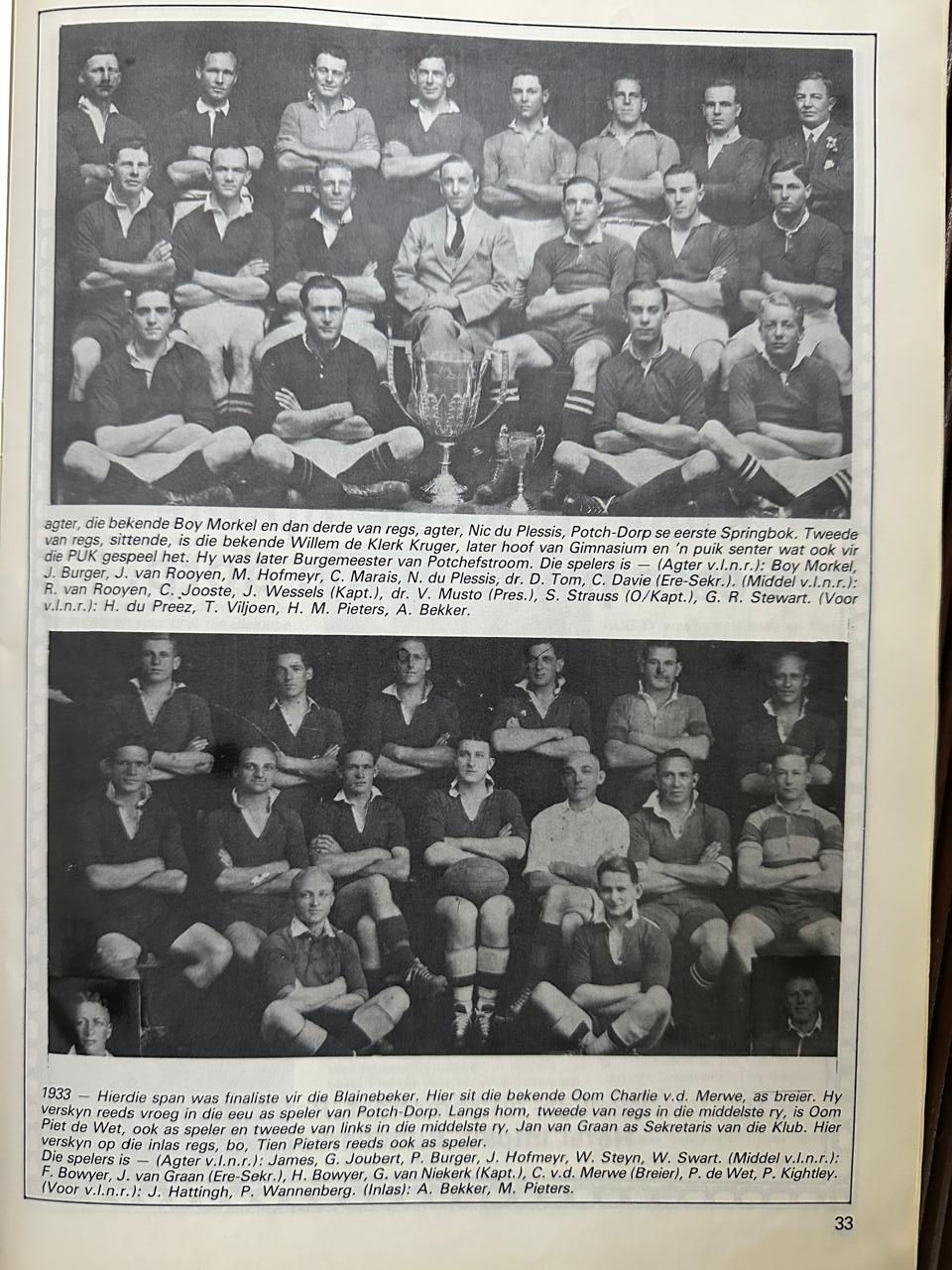History of Potch Dorp Rugbyklub: From Blazer Buttons to Bloodied Boots
- Karen Scheepers

- May 14
- 3 min read
Before TV screens, official leagues, or even rugby boots with proper studs, the game in Potchefstroom was already being played with passion and pride. The Potchefstroom Dorp Rugbyklub has its roots in teams that emerged from dusty fields and town rivalries, Crusaders, Wanderers, and a growing student presence. These early decades laid the foundation for a club that would go on to shape South African rugby history. Let’s rewind the clock to the years between 1907 and 1940, when Dorp rugby was still being forged in black-and-white.

1907–1908: Crusaders, Wanderers & the Spirit of Rivalry
The Potchefstroom Crusaders and Potchefstroom Wanderers were two of the original clubs that helped shape the region’s rugby identity. In 1907, the Crusaders team featured players such as J. Watson, D. Swart, J. du Plessis, and D. de Wet, playing a critical role in developing club culture. By 1908, the Wanderers had established a formidable side with players like R. Hope, W.J. Savage, and H. Hiron, a club determined to lift the standard of the game in Potchefstroom.
These clubs laid the groundwork for the eventual formation of a unified club identity: Potchefstroom Dorp Rugbyklub.

1909–1913: Growth, Photos, and Prestigious Matches
A 1909 team photo includes prominent players such as J. de Beer, W. Pretorius, and J.H. Wessels, as well as J. Goetz and P. Smith. These were the early pioneers who wore the jersey with pride. By 1913, the Wanderers were already competing for the Toti Smuts Trophy, a regional cup of high prestige.
The 1913 team included talents like V. Wessels, T. Niemand, and C.J. Pretorius, men who built the fierce reputation that Potchefstroom rugby began to carry throughout Western Transvaal.

1920s: Post-War Passion and Structured Revival
After the war years, Dorp Rugbyklub entered a new era. Photos from 1920 and 1921 show tightly-knit squads with names like C.D. MacKenzie, J. van Rooyen, and L.C. Marnewick. These were the men who carried the flame after World War I, maintaining rugby's momentum and restoring its place in Potchefstroom’s social rhythm.
The 1929 team photo documents a proud Dorp side featuring players like J.H. Lategan, A. Human, and P. Kruger, legends at a time when team photos were as formal as weddings.

1930s: Blikbeker Battles and Club Leadership
The 1933 and 1934 Dorp teams competed in the famous Blikbeker tournament, symbolising top club dominance in the region. These squads featured players like M. Peters, A. Bekker, and R. Stewart. 1934 also marked the rise of figures like Jan van Graan, who later became a pivotal character in Potchefstroom rugby, both on the field and behind the scenes.
Another key figure was Piet de Wet, a club stalwart who joined Dorp in 1920 and played into the early 1930s. He was a respected leader who left a powerful legacy within the team and province.


1940: The Pre-War Peak and End of an Era
By 1940, Potchefstroom Dorp Rugbyklub had matured into a disciplined, respected, and cohesive club. That year’s team, pictured just before the outbreak of World War II, included players such as J.J. Ludick, H. Peters, A.J. Steenekamp, and N.J. Koorts.
One of the standout players was M.G. (Tien) Pieters, whose career spanned over 20 years. Tien began playing for Dorp in 1931 and represented the club until well into the late 1940s. He also captained teams, became a club leader, and contributed to the Wes-Transvaal Rugby Union. His story is a testimony to Dorp’s ability to build not just players, but rugby men for life.
The Foundation That Still Holds
The period from 1907 to 1940 represents the bedrock era of Potchefstroom Dorp Rugbyklub. It was a time of black-and-white jerseys, handshake deals, muddy pitches, and unwavering commitment. The players were farmers, teachers, students, and soldiers, but when they put on the jersey, they became warriors of the Dorp.
What we see in these old team photos is more than just sporting pride, we see a town’s identity forming, a club’s voice rising, and a sporting tradition taking root.









Comments